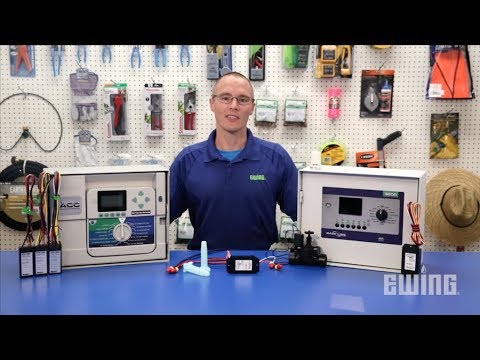Two-wire decoder systems for landscape irrigation
automation continue to gain in popularity in the industry. More and more designers are including them
in their plans so it makes sense to know about them if you are in the irrigation business. In a conventional setup, each valve, pump
relay, sensor, or switch requires its own separate wire connection to the controller. Two-wire decoders systems use just one two-wire
strand to connect everything in a daisy chain fashion. This is accomplished by using decoders that
are spliced into the two-wire strand then connected to the device you wish to control. Each decoder has a unique serial number that
is programmed into the controller in order to distinguish it from the others in the system. Also note that most manufacturers offer decoders
in multiple station models. So if you have a group of valves in one location,
you can control more than one of them with a single decoder. The benefits of using a two-wire system include:
Reduced material costs.
Copper wire can be expensive so using just
one two-wire strand means you won't need as much of it. While you may not see a savings on smaller
systems due to the added cost of the decoder, large commercial and industrial jobs can see
significant cost reductions. You can also save on controller costs. A traditionally wired system may require multiple
controllers to operate the site while a two-wire system can manage hundreds of zones using
just one controller.
Ease of expansion. If you need to add zones in the future, you
can simply splice into the existing two-wire strand to add an additional decoder. You can also branch off the existing strand
to reach a new location. Two-wire controllers can also handle multiple
paths so if you need to add a whole new run, you can do that as well. Longer wire runs. Depending on the manufacturer and the wire
gauge used, two-wire paths can extend much further than is possible with a conventionally
wired system. This makes reaching remote valve locations
much easier, opening up more options for irrigation design. Simplified maintenance. Having only one strand of wire to deal with
makes it easier to locate and repair faults.
Some decoders can also relay important status
information back to the controller from devices like sensors, switches, and solenoids. In addition to making smart irrigation decisions,
the controller can use this information to send an alert if there's a problem. Be aware the two-wire systems also have certain
requirements to ensure proper operation. For example, the wire should be double jacketed
and insulated, solid core copper wire. Also, the wire should be coated in polyethylene
rather than PVC. PVC coated wire is more likely to crack, which
could inhibit data transmission. Waterproof connectors like the DBRY-6, or
their equivalent, should be used to connect the decoders to the two-wire path. Conventional waterproof connections are still
okay to use for connecting the decoder to the device. Finally, grounding is extremely important
to the protection of the decoders from static charge or electrical storms. This is done through the use of grounding
rods and surge protectors. Keep in mind that two-wire decoder systems
vary in abilities and requirements from manufacturer to manufacturer so research the product thoroughly
to ensure that it fits your needs.
If you'd like to learn more about two-wire
decoder systems or other landscape and irrigation topics, be sure to sign up for one of our
live seminars. Stop by your local Ewing branch to learn more
or visit us online at ewingirrigation.com..
